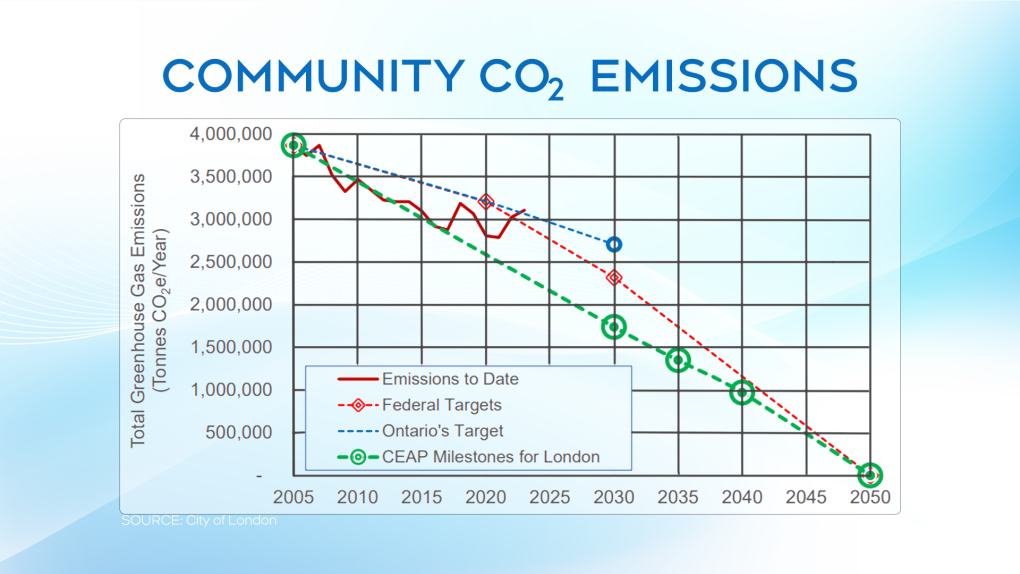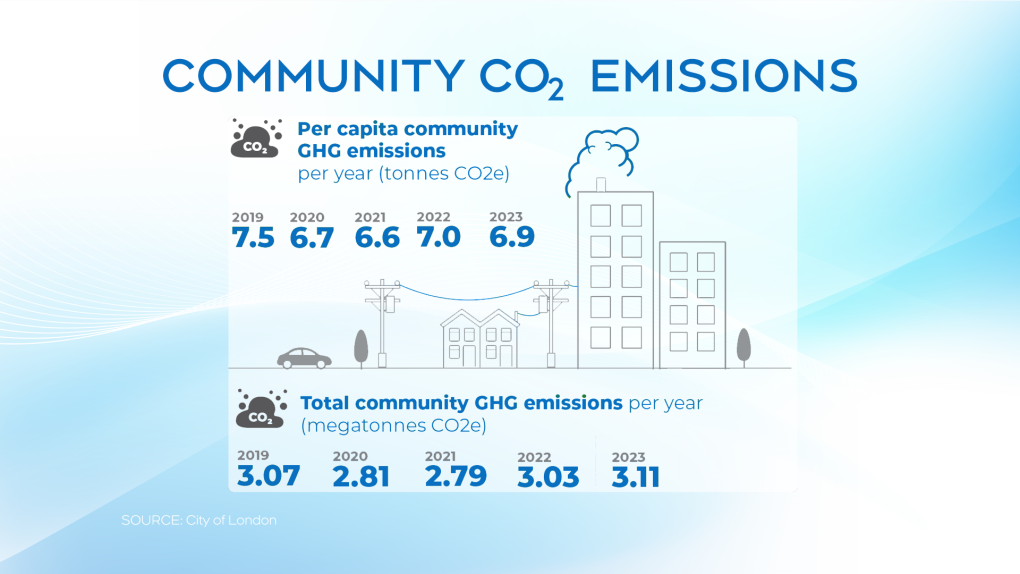London’s carbon emissions higher than when council declared a climate emergency five years ago
A progress report on the Climate Emergency Action Plan (CEAP) reveals that total amount of greenhouse gas emissions from London in 2023 were higher than in 2019 when council declared a climate emergency.
“Our progress is kind of a mixed bag of things,” admitted Jay Stanford, Director of Climate Change, Environment, and Solid Waste. “There's a couple of good news stories in there, and there's some things that are uncomfortable and actually heading in the wrong direction at this point in time.”
In 2022, city hall launched its Climate Emergency Action Plan that aims to reduce greenhouse gas emissions 55 percent (from 2005 levels) by 2030 and reach net zero by 2050.
However, the latest results aren’t encouraging.
In 2023, London released the equivalent of 3.11 megatonnes of carbon dioxide into the atmosphere.
That’s higher than the 3.07 megatonnes released in 2019 prior to the pandemic.
 Total GHG emissions in London compared to targets (City of London)
Total GHG emissions in London compared to targets (City of London)
Back-to-back annual increases are pushing London further off the projections needed to achieve its emission targets set out in the CEAP.
“It shows you how much work is still required over the next 6 to 7 years,” explained Stanford. “So we've got to pull up our socks and work a little bit harder, but these are the challenges that all municipalities in Canada and across North America have.”
The update report cites several factors contributing to higher GHG emissions:
- Market share of pick-ups and SUVs is higher
- Electric Vehicle (EV) adoption rate below average
- Pace of building energy retrofits not fast enough
- Provincial decision to increase percentage of fossil fuels (natural gas) in electricity generation
 GHG emissions in London (City of London)
GHG emissions in London (City of London)
“If you look at the variation between our 2030 target and today, that's just six short years,” warned Mary Ann Hodge of Climate Action London. “How are we ever going to get there unless we actually put some money and some energy towards it?”
Hodge believes city council must show a commitment during budget season to meet the targets of its climate emergency action plan.
She added, “I feel like council isn’t at all treating this like an emergency. It's like it's an afterthought.”
More than half of the GHG emissions in London are the result of home energy use and personal vehicles.
Last year, EV sales were 11.7 per cent of the Canadian car market, 7.7 percent in Ontario, but just 4.3 percent in London.
“We are in a hotbed in southwestern Ontario with respect to electric vehicle manufacturers and battery production, so I think it's just a matter of time before we do catch up,” said Stanford.
The Strategic Priorities and Policy Committee will receive the progress report on the Climate Emergency Action Plan at its meeting on August 15.
CTVNews.ca Top Stories

DEVELOPING Hundreds of thousands of customers lose power in Quebec as heavy rain hammers province
Nearly half a million households were in the dark Friday as remnants of Tropical Storm Debby wreaked havoc on southern Quebec.
No 'vaccine bans' coming to Alberta despite podcast comments
The province says no changes are coming to Alberta's COVID-19 vaccine availability, despite what appear to be claims from a UCP MLA that the government has discussed banning the shot.
Canada's Katie Vincent wins sprint canoe gold, breaks national medal record
Canadian sprint canoeist Katie Vincent has won her second medal at the Paris Olympics, capturing gold in the women's single 200-metre final Saturday.
Cringy moves and a white b-girl's durag prompt questions about Olympic breaking's authenticity
From the Australian b-girl with the meme-worthy 'kangaroo' dance move to the silver-medal winning Lithuanian in a durag, breaking's Olympic debut had a few moments that raised questions from viewers about whether the essence of the hip-hop art form was captured at the Paris Games.
Trump said he ‘went down’ in helicopter 'emergency landing' with former San Francisco mayor, who says it never happened
Former U.S. president Donald Trump recounted a story to reporters on Thursday about being involved in a helicopter emergency landing with former San Francisco Mayor Willie Brown.
In Las Vegas, Kamala Harris sees a chance to improve her odds of winning
U.S. Vice President Kamala Harris is working to make Nevada look like less of a political gamble in November's election.
In years following legalization, Canada had world's fastest-growing rate of MAID deaths, says report
In its first full year in practice, 2,838 patients died by MAID. The most recent government data shows 13,241 Canadians died by MAID in 2022, accounting for 4.1 per cent of all deaths in the country that year.
'Original sin': Torture of 9/11 suspects means even without plea deal, they may never face a verdict
A U.S. Defense Department disagreement over how to bring to justice the accused mastermind of the Sept. 11 attacks and two others has thrown the cases into disarray and surfaced tension between the desire of some victims' families to see a final legal reckoning and the significant obstacles that may make that impossible.
Philippine military says Chinese air force jets endangered its patrol plane with flares, risky moves
The Philippine military chief condemned Saturday what he said was the provocative actions of two Chinese air force aircraft that executed a dangerous maneuver and dropped flares in the path of a Philippine air force plane on routine patrol in the South China Sea.


































